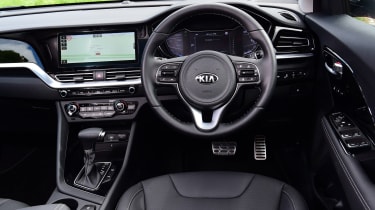Kia Niro (2016-2022) review - Interior, design and technology
It's no head-turner, but the Kia Niro feels solidly built and offers good levels of standard equipment

With its traditional compact family hatchback proportions, subtly raised ride height and tough-looking black wheelarch surrounds, the Kia Niro follows a template set by fashionable, conventionally powered crossover models.
It lacks the instant head-turning appeal of a Prius, but this more conventional shape gives the Kia plenty of showroom appeal. Its smattering of off-roader styling cues and less adventurous design approach will be a big draw to buyers who want hybrid efficiency without shouting about it. Better still, the plug-in variant is even more discreet – with the only clues to its 30-mile EV range being an additional filler cap by the nearside front wheel.
Go for the e-Niro, and the big indicator of its purely electric drive is the removal of the hybrid's grille. That leaves a blank piece of bodywork - much like Hyundai has done with its Ioniq and Kona Electrics - and there's a charging socket hidden behind the offset panel in the nose.
The subtle design continues inside, where the Niro feels far more mainstream than a Prius. Yet what it lacks in flair, the interior makes up for with solidity. Everything seems robustly built, while most of the materials have a high-quality look and feel.
Used - available now
For instance, soft-touch plastic covers the top of the dashboard, and the use of gloss black trim inserts and metal-effect air vent surrounds helps give the cabin an upmarket lift. One eco-minded feature is that you can set the climate controls to focus solely on the driver if you're travelling one-up - this is an eco feature that was first seen on the Kia Soul EV.
Sat-nav, stereo and infotainment
The entry-level Niro 2 includes an 8.0-inch touchscreen, while the Niro 3 features an upgraded 10.25-inch display with sat nav. Both are pretty easy to operate, with clear graphics and straightforward destination inputs. The screen also incorporates a row of shortcut buttons beneath the display, which means it’s easy to navigate between the assorted menus for the system settings, audio input, phone and the car’s energy flow.
A further clue to the Niro’s petrol-electric underpinnings is the unique instrument cluster, which features a full-colour 4.2-inch TFT screen and a power meter in place of the traditional rev counter. The 4 trim level and all e-Niro versions include a larger 7.0-inch display.
This set-up allows you to monitor the energy flow between the batteries, electric motor, engine and wheels, plus it generates numerous fuel use statistics. And as a bit of fun, there’s a neat graphic that ‘grows’ a tree as you drive more efficiently.
All Niro versions include two USB sockets and Apple CarPlay and Android Auto as standard. The Niro 3 adds a wireless phone charging pad, while the 4 trim has a JBL sound system with subwoofer in the boot.












